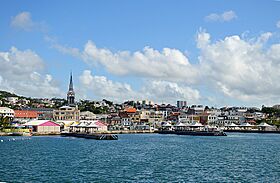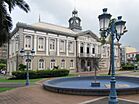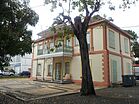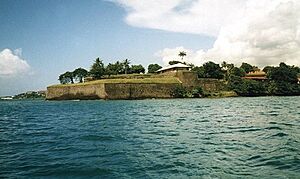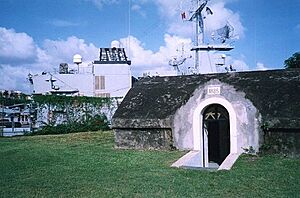Fort-de-France facts for kids
Quick facts for kids
Fort-de-France
|
||
|---|---|---|
|
Prefecture and commune
|
||
|
Top: Fort-de-France skyline; Middle: Fort-de-France Cathedral,Fort Saint Louis; Bottom: Fort-de-France Town Hall, Regional Museum of History and Ethnography of Martinique
|
||
|
||

Location of the commune (in red) within Martinique
|
||
| Country | France | |
| Overseas region and department | Martinique | |
| Arrondissement | Fort-de-France | |
| Intercommunality | CA Centre de la Martinique | |
| Area
1
|
44.21 km2 (17.07 sq mi) | |
| Population
(2021)
|
74,921 | |
| • Density | 1,694.66/km2 (4,389.2/sq mi) | |
| Time zone | UTC−04:00 (AST) | |
| INSEE/Postal code |
97209 /97200 and 97234 (Quartier de Balata)
|
|
| Elevation | 0–1,070 m (0–3,510 ft) | |
| 1 French Land Register data, which excludes lakes, ponds, glaciers > 1 km2 (0.386 sq mi or 247 acres) and river estuaries. | ||
Fort-de-France is the main city and capital of Martinique. Martinique is an island in the Caribbean Sea and is a part of France. It's like a special region of France, but far away across the ocean!
Contents
History of Fort-de-France
Fort-de-France has a long and interesting history. It started as a fort and grew into a busy city.
Building Fort Saint Louis
In 1638, a man named Jacques Dyel du Parquet decided to build a fort. This fort was called Fort Saint Louis. Its job was to protect the city from attacks. The first fort was destroyed, but a new one was built in 1669. This new fort was designed by a famous engineer named Vauban.
Changing Names
The city was first called Fort-Royal. For a long time, another city called Saint-Pierre was more important. Saint-Pierre was known for its shops and culture. People even called it "The Paris of the Caribbean."
During the French Revolution, Fort-Royal was briefly called "Fort-La-Republique." Later, in the 1800s, its name changed to Fort-de-France. Even today, people in Martinique sometimes use the old Creole name "Foyal" for the city. People from Fort-de-France are called "Foyalais."
Important Events
In 1762, British forces took control of Martinique, including Fort-de-France. But the island was given back to France in 1763 after a peace agreement called the Treaty of Paris.
The city faced some tough times. In 1839, a small earthquake hit. Then, in 1890, a big fire destroyed part of the city. However, things changed in 1902. A volcano called Mount Pelée erupted and destroyed Saint-Pierre. This made Fort-de-France the most important city on the island for trade and business.
Before 1918, Fort-de-France had problems with its water supply. It was also surrounded by swamps and had issues with yellow fever. But over time, the swamps were drained. This helped the city grow and become healthier.
In 1945, an airplane crashed in the water near Fort-de-France. It was a Sikorsky S-43 plane arriving from Port of Spain. Sadly, 4 out of 14 people on board died.
Geography
Fort-de-France is located on the west coast of Martinique. It sits at the entrance of a large bay called Fort-de-France Bay. The Madame River flows into the sea here. The city is built on a narrow flat area between hills and the ocean. Roads connect it to all other parts of the island.
Climate
Fort-de-France has a tropical rainforest climate. This means it's very warm to hot and humid all year round. The wettest months are from July to November. During this time, hurricanes can be a threat. But it rains a lot in all months. September is usually the hottest month, and February is the coolest.
| Climate data for Fort-de-France (1991–2020 averages, extremes 1932–present) | |||||||||||||
|---|---|---|---|---|---|---|---|---|---|---|---|---|---|
| Month | Jan | Feb | Mar | Apr | May | Jun | Jul | Aug | Sep | Oct | Nov | Dec | Year |
| Record high °C (°F) | 31.5 (88.7) |
32.1 (89.8) |
33.6 (92.5) |
33.0 (91.4) |
33.9 (93.0) |
33.6 (92.5) |
33.6 (92.5) |
33.0 (91.4) |
33.8 (92.8) |
33.0 (91.4) |
32.1 (89.8) |
31.3 (88.3) |
33.9 (93.0) |
| Mean daily maximum °C (°F) | 27.7 (81.9) |
27.9 (82.2) |
28.5 (83.3) |
29.3 (84.7) |
29.8 (85.6) |
29.6 (85.3) |
29.7 (85.5) |
30.2 (86.4) |
30.5 (86.9) |
30.2 (86.4) |
29.2 (84.6) |
28.2 (82.8) |
29.2 (84.6) |
| Daily mean °C (°F) | 25.0 (77.0) |
24.9 (76.8) |
25.4 (77.7) |
26.2 (79.2) |
26.8 (80.2) |
27.0 (80.6) |
26.9 (80.4) |
27.3 (81.1) |
27.5 (81.5) |
27.2 (81.0) |
26.4 (79.5) |
25.6 (78.1) |
26.4 (79.5) |
| Mean daily minimum °C (°F) | 22.2 (72.0) |
22.0 (71.6) |
22.3 (72.1) |
23.1 (73.6) |
23.6 (74.5) |
24.3 (75.7) |
24.2 (75.6) |
24.4 (75.9) |
24.5 (76.1) |
24.2 (75.6) |
23.7 (74.7) |
23.0 (73.4) |
23.5 (74.3) |
| Record low °C (°F) | 17.8 (64.0) |
17.3 (63.1) |
18.6 (65.5) |
18.9 (66.0) |
19.9 (67.8) |
20.0 (68.0) |
18.4 (65.1) |
19.5 (67.1) |
17.9 (64.2) |
20.2 (68.4) |
19.7 (67.5) |
17.4 (63.3) |
17.3 (63.1) |
| Average precipitation mm (inches) | 113.9 (4.48) |
76.5 (3.01) |
70.5 (2.78) |
108.8 (4.28) |
133.0 (5.24) |
154.1 (6.07) |
205.6 (8.09) |
246.7 (9.71) |
213.9 (8.42) |
243.0 (9.57) |
236.7 (9.32) |
147.8 (5.82) |
1,950.5 (76.79) |
| Average precipitation days (≥ 1.0 mm) | 18.6 | 14.1 | 12.2 | 12.6 | 13.2 | 17.0 | 20.6 | 19.2 | 17.2 | 18.0 | 19.2 | 18.1 | 200.0 |
| Mean monthly sunshine hours | 204.2 | 197.6 | 222.1 | 209.5 | 207.5 | 190.3 | 201.5 | 224.6 | 205.3 | 187.4 | 183.2 | 204.0 | 2,437 |
| Source 1: Météo France | |||||||||||||
| Source 2: Meteociel.fr (sunshine 1981-2010) | |||||||||||||
Population
The number of people living in Fort-de-France has changed over the years. You can see how the population has grown and shrunk in the table below.
| Historical population | ||
|---|---|---|
| Year | Pop. | ±% p.a. |
| 1961 | 84,811 | — |
| 1967 | 96,943 | +2.25% |
| 1974 | 98,807 | +0.27% |
| 1982 | 99,844 | +0.13% |
| 1990 | 100,080 | +0.03% |
| 1999 | 94,049 | −0.69% |
| 2007 | 89,794 | −0.58% |
| 2012 | 85,667 | −0.94% |
| 2017 | 80,041 | −1.35% |
| Source: SPLAF and INSEE (1967-2017) | ||
Fort Saint Louis in Fort-de-France is an important base for the French navy.
Main Sights
Fort-de-France has many interesting places to visit:
- The historic Fort Saint Louis
- Other forts like Fort Desaix, Fort Tartenson, and Fort Gerbault
- Place de la Savane, a large park in the city center
- Schoelcher Library, a beautiful building
- Jardin de Balata, a lovely botanical garden with many plants
- Sacré-Cœur de Balata Church, which looks like the famous church in Paris, but is surrounded by tropical forest
- Fort-de-France Cathedral
There used to be a statue of Empress Josephine in the gardens of La Savane. She was born in Martinique and was the wife of Napoleon. The statue was damaged in the 1990s and later destroyed in 2020. This happened because some people blamed her for supporting the return of slavery on the island.
Transport
The main airport for Martinique is Martinique Aimé Césaire International Airport. It is located just outside Fort-de-France and you can reach it by the A1 highway.
Notable People
Many famous people have come from Fort-de-France:
- Manon Tardon (1913–1989), a fighter in the Resistance during World War II
- Frantz Fanon (1925–1961), a well-known psychiatrist and writer
- Julienne Salvat (1932–2019), a teacher, poet, and actress
- Karine Jean-Pierre (born 1974), who became the White House Press Secretary in 2022
See also
 In Spanish: Fort-de-France para niños
In Spanish: Fort-de-France para niños


